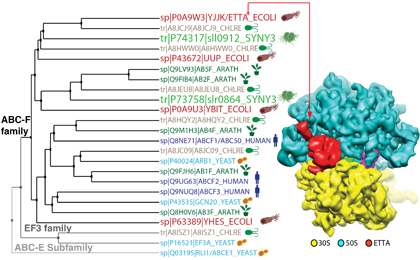Theme n°1:
ABC-F family factors
The ABC-F family factors is a family of soluble proteins belonging to the ABC (ATP Binding Cassette) superfamily. The proteins making up this superfamily are ATPases with homologous ABC domains. Most ABC proteins are membrane transporters, but the ABC-F family is characterized by soluble proteins. This family is the most common soluble protein within the ABC superfamily, conserved from bacteria to man. Four representatives of this family are present in Escherichia coli, two in the cyanobacterium Synechocystis, six in Chlamydomonas reinhardtii (including one chloroplast), five in plants, and three in man. With our collaborators, we have demonstrated that the predominant representative of the ABC-F family present in eubacteria, the EttA (energy-sensing translational throttle A) protein, is a translation factor that regulates ribosome entry into the elongation cycle in function of the ADP/ATP ratio.
In the presence of ADP, EttA inhibits the formation of the first peptide bond, thus blocking the entry of the initiation complex into the translational elongation cycle. The ATP-bound conformation of EttA stabilizes the initiation complex in a conformation favorable to the formation of the first peptide bond. This interaction stimulates ATP hydrolysis by EttA, leading to its dissociation from the ribosome and enabling the EF-G factor to catalyze the first translocation event and thus entry into the elongation cycle. In vivo, cells in which the ettA gene is inactivated have a defect in their ability to survive a long stationary phase when co-cultured with wild-type cells. It is known that during the stationary phase, intracellular ATP levels are low. Since translation of mRNA into protein consumes more than half of the cell's energy, it's not surprising to find a translation factor that regulates this process. We are now extending our study to the 3 other EttA paralogs present in E. coli and to EttA orthologs responsible for antibiotic resistance in several pathogenic bacteria. We are also studying the function of the two ABC-F proteins present in the cyanobacterium Synechocystis. Our aim is to map the different actions of ABC-F proteins on the translational apparatus.
Theme n°2:
Identification and functional characterization of new putative translation factors
In this second project, we will develop a screening methodology to identify the phenotype linked to translation defects in a collection of mutants. This collection will be made up of deletion mutants of proteins known to interact with the ribosome and whose function remains undefined. In parallel, we will attempt a pull-down approach to identify new factors that interact with blocked ribosomes during mRNA translation.